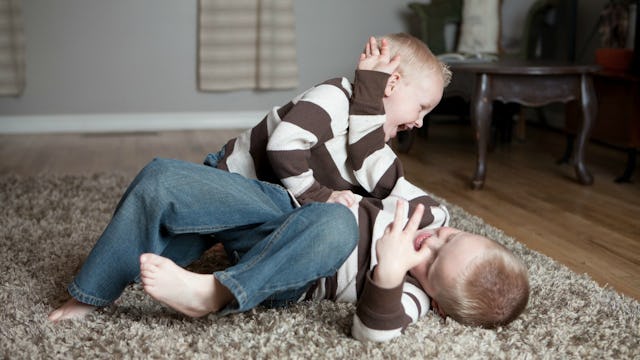7 Reasons I Love Kids’ Rough Play -- And How I Make Sure It’s Safe

My husband, Ryan, had just dropped off our three-year-old at preschool— the same preschool where I used to teach and now sit on the board. When I answered the phone, Ryan nervously laughed and said, “So, I just left school, and I was wondering if you could— as a teacher— help me understand what I just saw.” Well, my curiosity was piqued.
“I’m sure there’s more to it than this…but it looks like the teacher is running a baby cage fighting ring,” he said.
“Do you mean the gymnastics mats are out and that kids are wrestling?” I asked.
“Maybe,” Ryan said. “Tell me more.”
Openness to understanding the rougher kinds of play benefits everyone, but probably most of all, the children. Have you ever sat in a long meeting and felt as though your body was craving movement? I get jittery, nervous, and I stop listening, which means I’m no longer absorbing any information— at least until a break where I can walk around and stretch. Kids’ brains and bodies work like that too. When they start to feel jittery, their brains have a hard time focusing.
This is why recess and free play are so important in school. Not all kids will show interest in wrestling or jumping in the mud or even basketball. But all kids absolutely need full-body, high impact play of some sort. I believe that should be embraced for a few reasons.
7 Reasons I Love Rough Play:
1. Kids who play rough are seeking the play experiences their bodies’ need.
Kids are drawn to the type of play their brains need to grow and develop— and what each child needs to play is unique to each child.
2. Children are often more calm and focused after engaging in rough play.
Their bodies feel a sense of relief much like adults do after a cathartic cry or good workout.
3. When children engage in rough play with other children, they are developing social and emotional knowledge in real time.
They have to adjust their speed and the degree to which they push and pull with the other child. To do that, kids must read each other’s cues and listen to each other.
4. Every child’s interest in and tolerance for rough play is different. This teaches children the importance of consent.
All kids involved must agree on the rules for the rough play. All kids involved must agree to say “stop” when they start to feel overwhelmed or uncomfortable, and the others playing must stop immediately when that is said. This teaches kids how to express consent and how to listen for whether others are feeling safe with the game.
5. Rough play is valuable for all children, not just boys.
6. Children can learn to safely play rough.
Society has become overly cautious about unstructured and child-led play. It seems counterintuitive, but I’ve noticed both with students and my own sons that kids are often much more in control of their actions after some good rough wrestling. That’s why I was thrilled when Ryan called about the wrestling happening at our preschool. Rough and safe are not opposites. Kids need a balance in order to reap the benefits of rough play. Let’s take wrestling as an example.
Here’s how we keep kids safe when wrestling at my son’s preschool:
1. Set some limits.
We define a space with fold-out, gymnastics mats and insist that while wrestling only two kids without shoes on can wrestle at a time.
2. Ask the kids for input.
We write down a list of the kids’ wrestling rules before we start playing. We write down everything that the kids say and make sure that everyone agrees. (It’s preschool, so someone always offers a rule like “no pooping on the other person’s head,” but write it down anyway. They will come up with some important rules like “no touching faces.”) If there’s something I think should be a rule that isn’t, I’ll ask, “So is it okay if someone pushes you down?” They say no, so we add it to the list.
3. Emphasize consent.
Everyone should feel comfortable. The most important rule is that if someone says “no” or “stop” everyone has to freeze before we move on. Typically, the kids’ rules leave room only for semi-aggressive hugging. Kids only wrestle someone that they choose to wrestle.
The best thing about the list above is that it can be modified for all kinds of activities. Making mud pies, rocking out with pots and pans, crashing matchbox cars, and yelling while playing freeze tag! It’s all
so valuable. Rough play increases gross motor development and leaves kids feeling calmer and focused, but the most valuable aspect is the development of social skills. They really have to listen to the other person because if the other person stops playing, the game is over. They also have to be vocal about communicating their own boundaries.
They have to control their bodies so that they are not hurting anyone including themselves. They have to constantly adjust in response to the other person. Almost always rough play must be supervised, but I deeply believe in the power of letting kids learn through wrestling, making noise, and making messes. That’s when powerful learning happens!
This article was originally published on